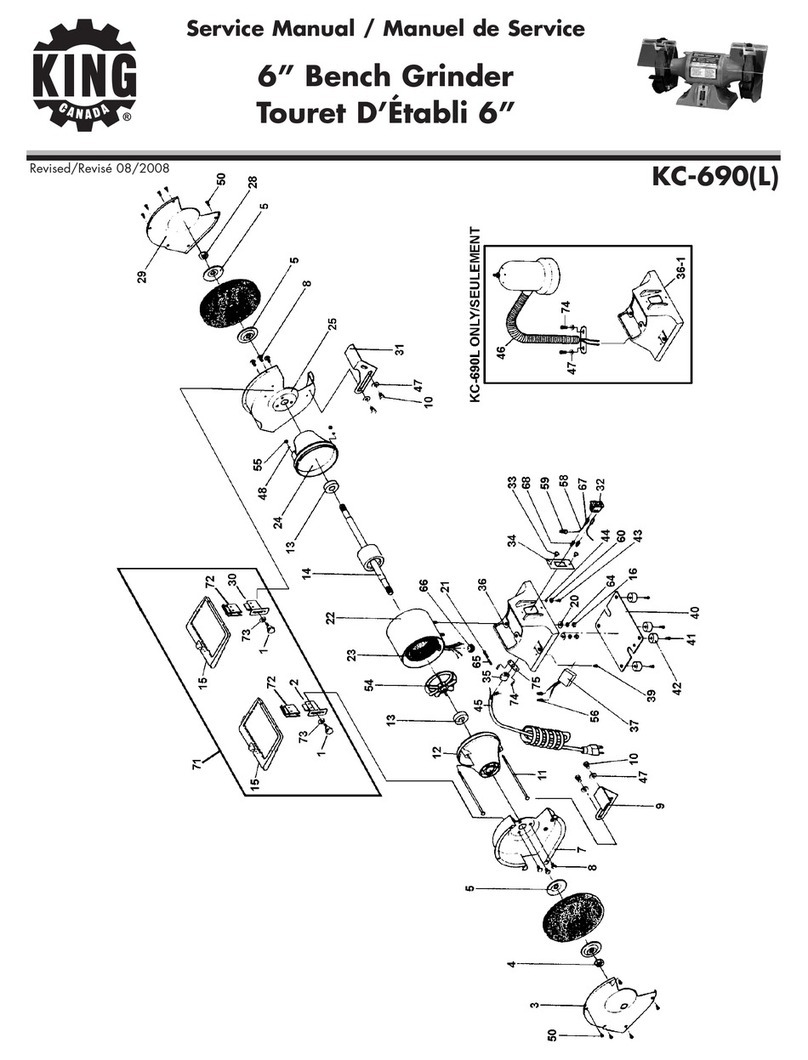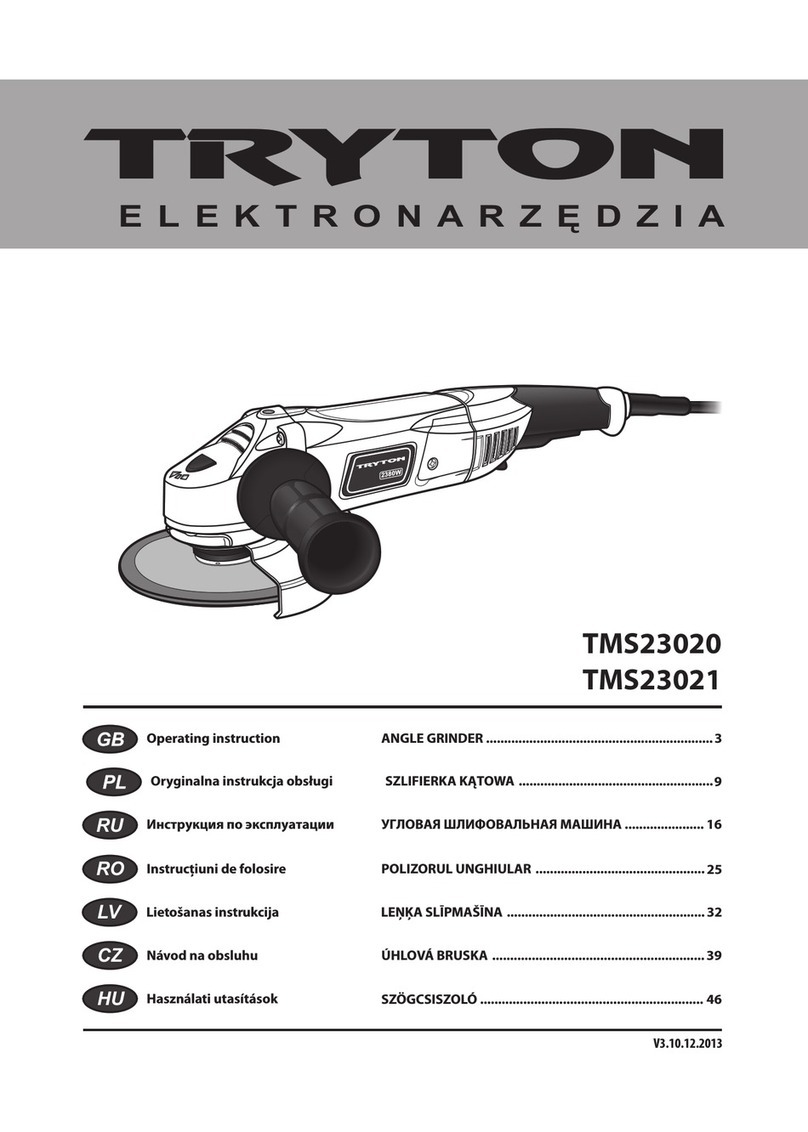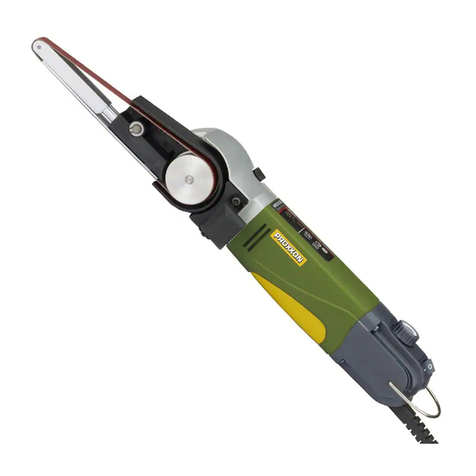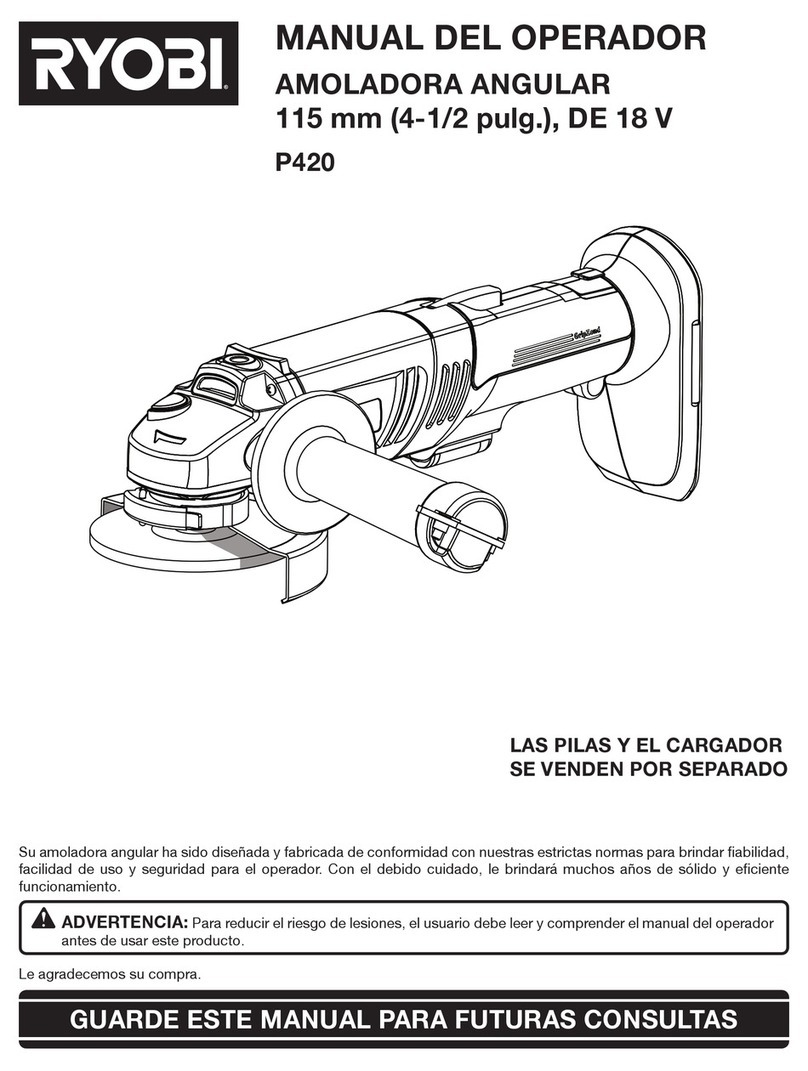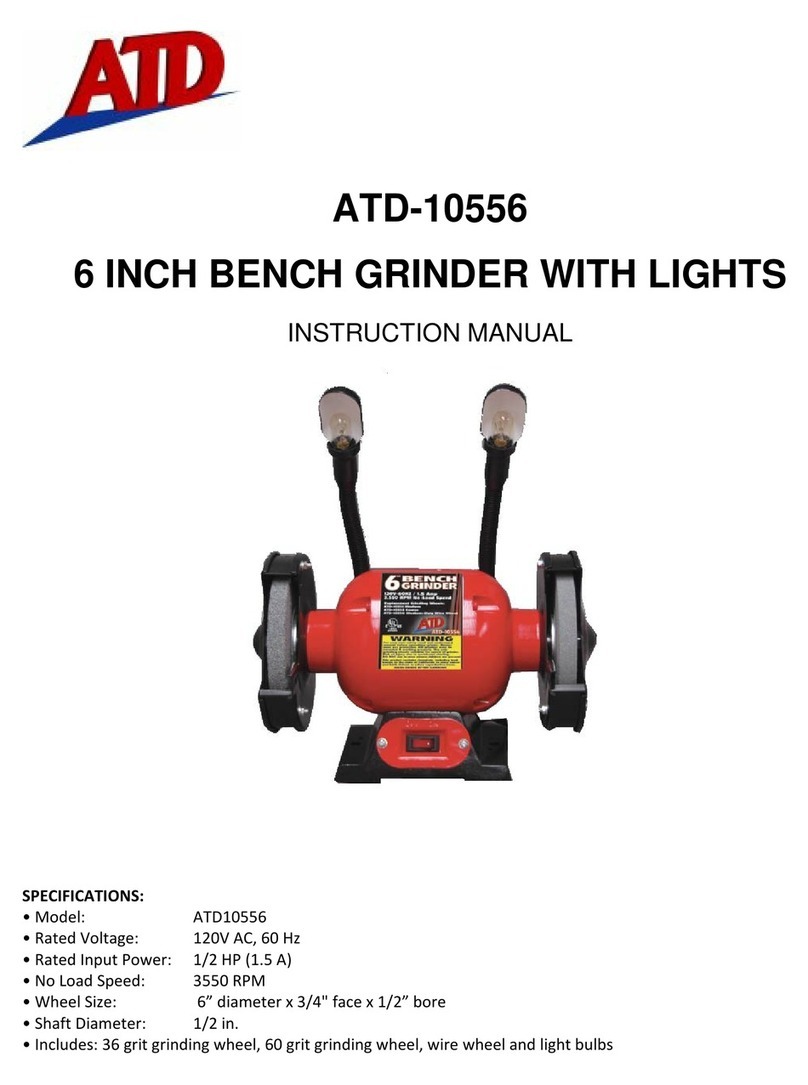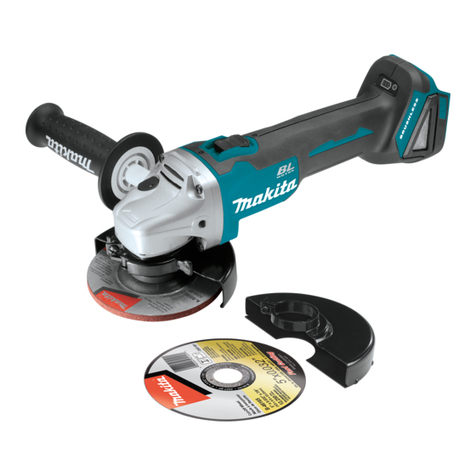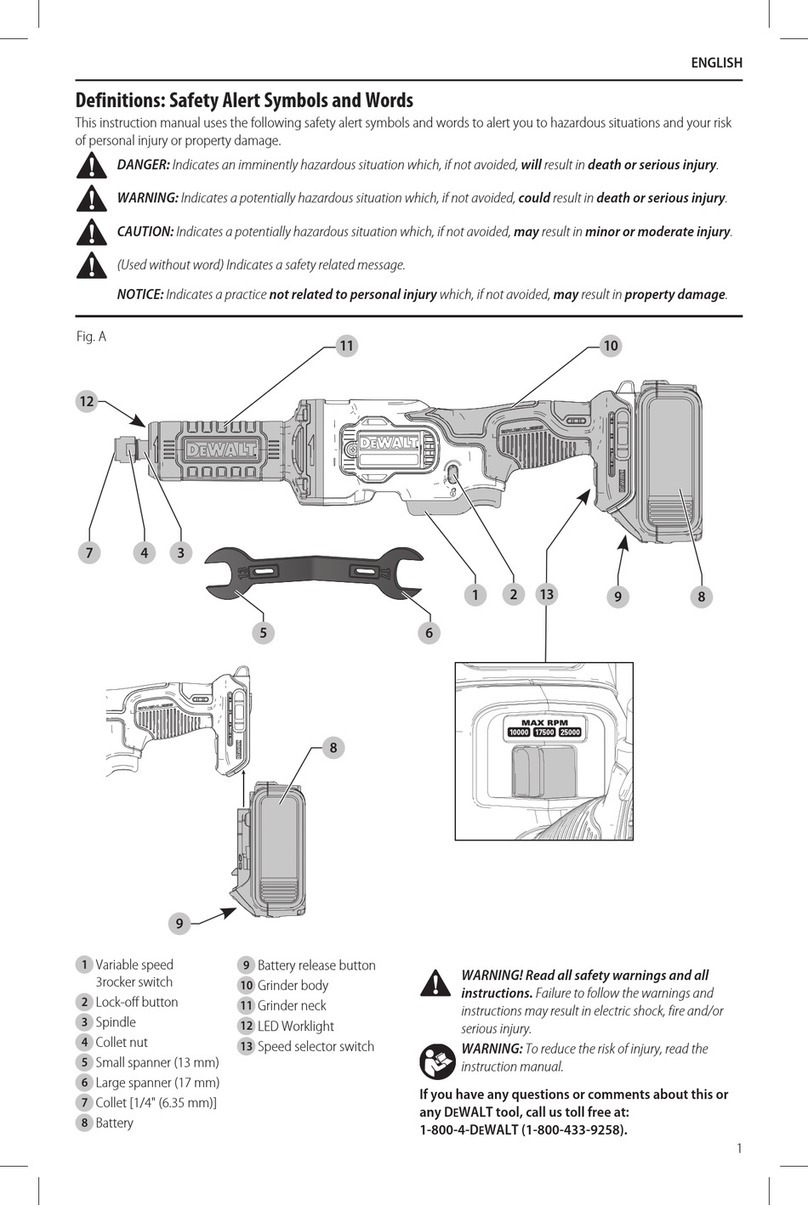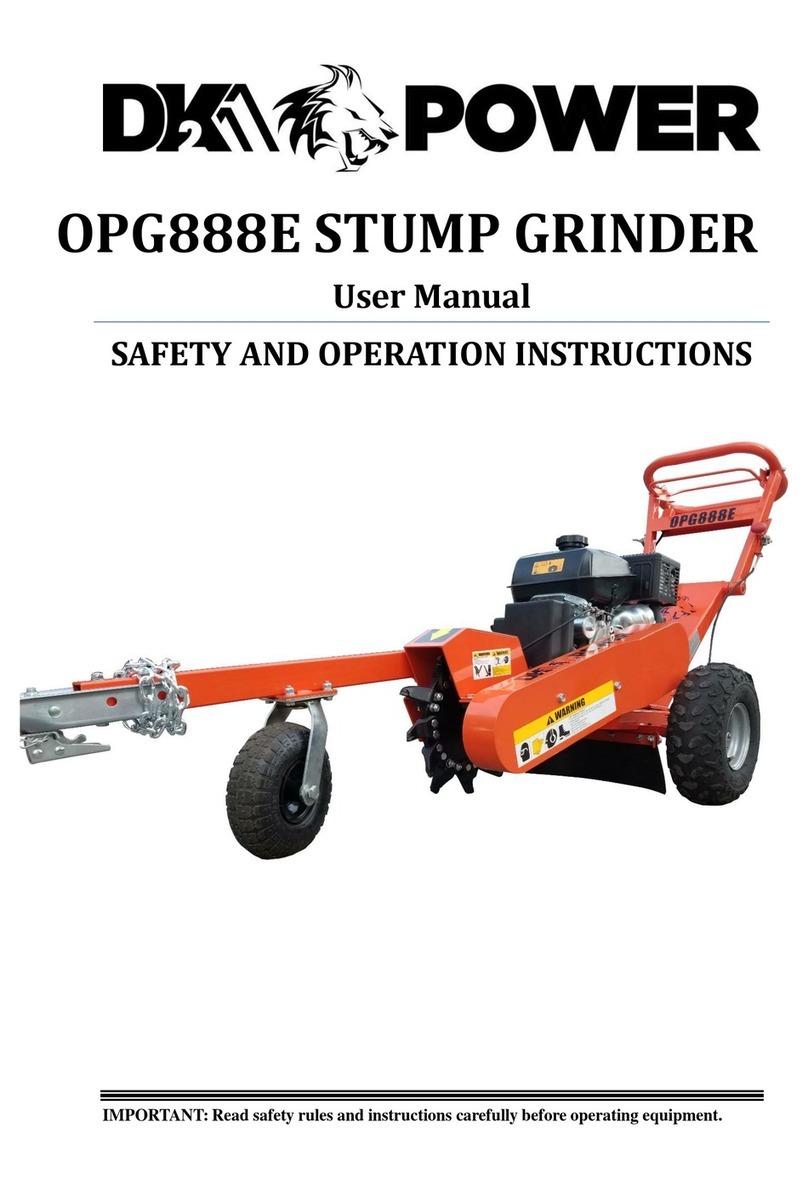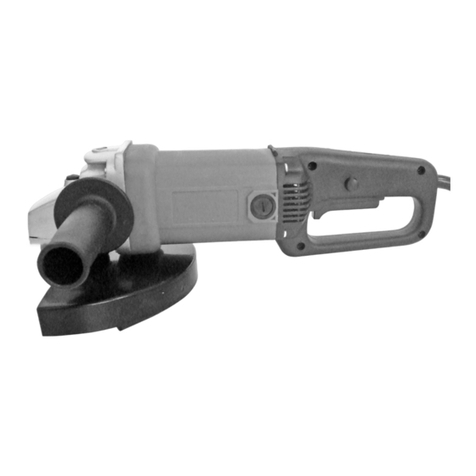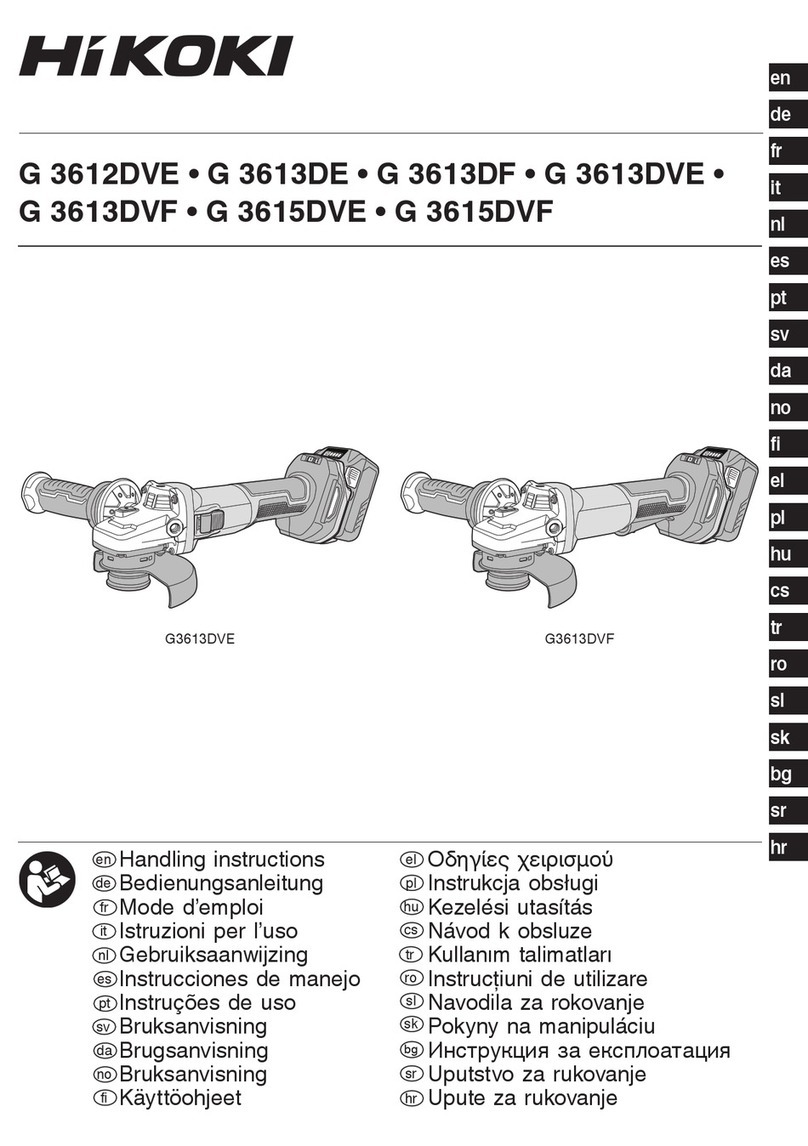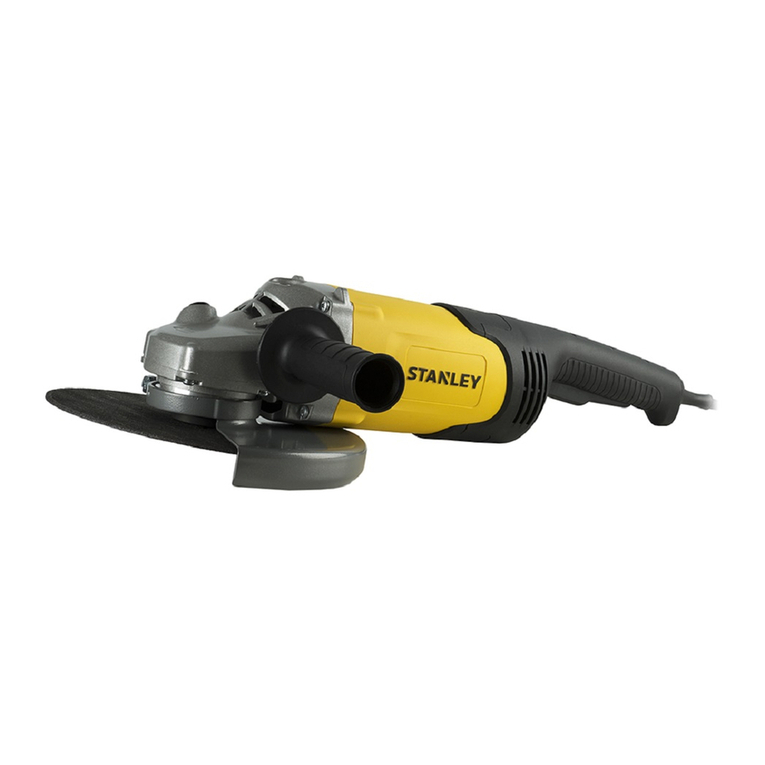Nemo AG-22-5Li-50 User manual


1
Functional Description and Specifications
Intended Use
The Nemo Submersible Angle Grinder is the world’s first and only
waterproof electric grinder, designed for performing cutting,
grinding, polishing, and other high intensity jobs, both underwater
and on dry land.
Packing List
Your Nemo Submersible Angle Grinder is packaged together with
the following accessories:
♦22V 5ah Lithium Polymer (Li-po) battery
♦Battery charger
♦Hand pump
♦Wheel guard (125mm)
♦Lock nut wrench
♦Side handle
♦Inner flange
♦Outer flange
♦Carrying case
Technical Specifications
Battery Charger
Model TB-GC-NT
Approximate charging time 90 minutes
Charging output voltage 25.2V
Charging input voltage 110V – 220V

2
Nemo Submersible Angle Grinder
Model AG-22-5Li-50
Battery pack voltage 22V 5Ah Li-po
Battery cell specification 5Ah
Motor 1500 watt
Maximum speed (submerged) 6500 RPM
Maximum speed (dry) 9500 RPM
Net weight (with battery) 2.9kg (6.39 lbs)
Overall length 38cm (15 in)
Wheel diameter 115mm (4.5 in)
Spindle thread size International: M14 (14mm)
U.S.: 5/8 in 11 UNC
Submersible up to 50m (164 ft)
Caution: You must pressurize the angle grinder before
you can use it underwater, as described in Pressurizing
the Angle Grinder for Underwater Use, page 21.

3
Safety Warnings
Warning:Read all safety warnings and instructions, and
save them for future reference. Failure to adhere to
these warnings can result in serious injury and damage
to equipment.
Work Area Safety
♦All work should be done in accordance with the local, state,
and government occupational safety and health guidelines.
♦Keep your work area clean and well lit.
♦Do not operate power tools in explosive atmospheres, such as
in the presence of flammable liquids, gases, or dust.
♦Keep bystanders and children away when operating power
tools.
Personal Safety
♦Stay alert and use common sense when operating power tools.
♦Do not use power tools when you are tired or under the
influence of drugs, alcohol, or medication.
♦Use personal protective equipment. It is recommended to
always wear eye protection, as well as a P2 filter-class
respirator.
♦Dust from materials such as lead-containing coating, some
wood types, minerals, and metal can be harmful to one’s
health. Observe the relevant regulations in your country for the
materials to be worked.
General Power Tool Safety
♦Store idle power tools out of reach of children, and do not
allow persons unfamiliar with the power tool or these
instructions to operate the power tool.

4
♦Maintain your power tools. Check for misalignment or binding
of moving parts, breakage of parts, and any other conditions
that may affect the power tool’s operation. If damaged, have
the power tool repaired by an authorized service technician.
Caution:Under no circumstances should the power
tool be opened for repairs or any other purpose by
anyone other than an after-sales service technician
authorized by Nemo Power Tools. Opening the power
tool invalidates the manufacturer warranty.
♦Use power tools and accessories in accordance with these
instructions and in the manner intended for the particular type
of power tool, taking into account the working conditions and
the work to be performed. Consult local, state, and
government occupational safety and health guidelines before
operating a power tool.
♦Hold the power tool with a firm grip.
♦Work only on stable items. Do not hold any workpiece in your
hand. Secure the workpiece with clamping devices or in a vice.
♦Always wait until the power tool has come to complete stop
before placing it down.
Angle Grinder Safety
♦Always use safety glasses or goggles and the appropriate
protective gear when working with the angle grinder.
♦Always use a wheel guard when working with a grinding wheel
to protect yourself from broken wheel fragments.
♦Only use accessories rated for at least the speed recommended
on the angle grinder’s warning label. Accessories that run over
their rated speed can fly apart and cause injury.
♦Never use the angle grinder with wood cutting blades or other
sawblades. These blades frequently kick when used on an angle
grinder, causing loss of control and injury.

5
♦Only use fiberglass-reinforced depressed center grinding
wheels.
♦Do not use damaged wheels. Check the wheels for damage and
flaws by running the tool with the wheel guard and no load for
about a minute. In addition, check the wheel for vibration and
wobbling, which indicate a loose or unbalanced wheel.
♦Only use the flanges specified for this angle grinder.
♦Do not damage the spindle, the flange, or the lock nut, as
damage to these parts could result in wheel breakage.
♦Hold the angle grinder by its insulated surfaces when it might
contact live wires during operation. Contact with live wires will
make the exposed metal parts of the angle grinder live, which
can lead to electrocution.
♦Keep your hands away from the rotating parts of the angle
grinder.
♦Only operate the angle grinder when you are holding it
securely. Never leave the angle grinder running.
♦Ensure the wheel does not touch the workpiece before the
angle grinder is switched on.
♦Always hold the angle grinder so that sparks fly away from you,
other people, and flammable materials.
♦Do not force the angle grinder or apply excessive pressure. The
weight of the angle grinder should provide adequate pressure.
When required, adjust the pressure on the angle grinder so
that it does not slow down during operation.
♦Do not bang the wheel or disc on to the workpiece.
♦Do not bounce or snag the wheel, particularly around corners
or edges, as this may cause loss of control and kickback.
♦Always refit the wheel or disc if you drop the angle grinder.
♦Do not touch the workpiece immediately after operation as it
might be extremely hot.

6
Rechargeable Battery Safety
♦Use only the battery pack supplied with your power tool.
♦When the battery pack is not in use, keep it away from other
metal objects like paper clips, coins, keys, nails, and screws,
which can make a connection from one terminal to another.
♦Store and charge the battery pack within a temperature range
of 0˚C - 45˚C (32˚F - 113˚F).
♦Before any work on the power tool, such as a tool change, as
well as during transportation and storage, remove the battery
pack from the power tool. There is danger of injury when
accidently activating the On/Off trigger.
♦Do not open the battery.
♦Protect the battery against heat, including continuous sun
irradiation and fire.
♦When the battery is defective, liquid can escape and come into
contact with adjacent components.
♦Use only original batteries with the voltage listed on the
nameplate of your power tool. When using other batteries,
such as imitations, reconditioned batteries, or other brands,
there is danger of injury as well as property damage through
exploding batteries.
♦Use only the battery charger provided with the power tool to
recharge the battery. Only this battery charger is matched to
the lithium polymer (Li-po) battery of your power tool.
♦Protect the battery charger from rain and moisture. The
battery charger is not waterproof.
♦Do not charge other batteries. The battery charger is suitable
only for charging the battery pack supplied with the tool.
♦Before use, always check the battery charger, cable, and plug. If
defects are detected, do not use the battery charger. Never
open the battery charger. Only have it opened and repaired by
qualified personnel who will use original spare parts.

7
Getting Started with the Angle Grinder
Your Nemo Submersible Angle Grinder (AG-22-5Li-50) includes the
following main components:
The On/Off trigger is a dead-man’s switch, and provides important
safety functionality. When you release the On/Off trigger, it
immediately cuts off power to the motor and stops the angle
grinder. You can only restart the angle grinder by moving the speed
selector switch to the Off (0) position before pressing the On/Off
trigger again, as described in Switching the Angle Grinder On or Off,
page 23.

8
Charging the Battery
The battery is supplied partially charged, and must be charged to
full capacity before using the angle grinder for the first time.
Caution: Only use the battery charger provided with
the angle grinder. Only this battery charger is matched
to the Li-po battery supplied with your power tool.
Danger:Ensure that the voltage of the power supply
corresponds with the data given on the nameplate of
the battery charger.
Danger:Only use the charger in a dry environment. The
charger is not waterproof. Never attempt to charge the
battery under water.
The battery can be charged at any time without reducing its service
life. The battery charger detects the charging condition of the
battery, and charges it with the optimum charging current for its
temperature and voltage. This lengthens the battery life, and leaves
it fully charged when stored in the charger.
Interrupting the charging procedure does not damage the battery.
Only charge the battery when its temperature is between 0˚C- 45˚C
(32˚ F - 113˚ F).
1. Connect the mains plug of the battery charger to an electrical
outlet. A steady green light on the battery charger indicates
that the charger is ready for operation.
2. Press the battery charger’s CHOGORI connectors into the
sockets on the top of the battery pack. There is only one
correct way to insert the connectors into the battery sockets.

9
The battery begins charging as soon as it is connected to the
charger.
A steady red light on the battery charger indicates that
the battery is charging.
A steady green light on the battery charger indicates that
the battery is fully charged.
3. When you are ready to use the battery, rotate the CHOGORI
connectors’ plastic caps counterclockwise and pull the
connectors vertically out of the charger.
Inserting a Battery into the Angle Grinder
1. Ensure the speed selector switch is in the Off position (0).
Caution:To minimize the risk of accidental activation,
ensure the speed selector switch is in the Off (0)
position before performing any maintenance on the
angle grinder, as well as during transport and storage.
Caution:Use only a Li-po battery from the original
factory with the voltage listed on the nameplate of
your angle grinder. Using other batteries not suitable
for the angle grinder can lead to malfunctions, cause
damage to the power tool, and pose a fire hazard.

10
2. Place the angle grinder on to the battery. There is only one
correct way to position the angle grinder on the battery.
3. Push the angle grinder down until it clicks into place, then close
the clips on either side of the battery to lock it in place. The
clips hold the battery pack in position and prevent it from
detaching.

11
Removing a Battery from the Angle Grinder
1. Ensure the speed selector switch is in the Off position (0).
Caution: To minimize the risk of accidental activation,
ensure the speed selector switch is in the Off (0)
position before performing any maintenance on the
angle grinder, as well as during transport and storage.
2. Open the clips on either side of the battery. These clips hold
the battery pack in position and prevent it from detaching.
3. Gently lift the angle grinder off the battery, without exerting
any force.
Fitting the Angle Grinder Side Handle
The side handle enables you to hold the angle grinder securely with
both hands. It is repositionable, and can be fitted on either side of
the angle grinder.
1. Ensure the speed selector switch is in the Off position (0).
Caution: To minimize the risk of accidental activation,
ensure the speed selector switch is in the Off (0)
position before performing any maintenance on the
angle grinder, as well as during transport and storage.
2. Screw the handle securely into one of the holes found on either
side of the angle grinder body.

12
Fitting the Angle Grinder Wheel Guard
The wheel guard protects you from sparks, debris, and fragments if
the wheel or disc shatters during use. Always ensure that the closed
side of the guard faces toward you. The wheel guard must be in
place before mounting all wheels or discs, except for abrasive discs.
1. Ensure the speed selector switch is in the Off position (0).
Caution: To minimize the risk of accidental activation,
ensure the speed selector switch is in the Off (0)
position before performing any maintenance on the
angle grinder, as well as during transport and storage.
2. Position the wheel guard (1) so that the protrusion on the
wheel guard band is aligned with the notch on the angle
grinder’s bearing box (2).
3. Rotate the wheel guard 180 degrees, and tighten the screw (3)
securely.
4. To remove the wheel guard, loosen the screw, rotate the wheel
guard back to its initial position, and then remove it from the
angle grinder.

13
Mounting a Depressed Center Grinding Wheel
1. Ensure the speed selector switch is in the Off position (0).
Caution: To minimize the risk of accidental activation,
ensure the speed selector switch is in the Off (0)
position before performing any maintenance on the
angle grinder, as well as during transport and storage.
2. Fit the inner flange (3) on to the spindle, on top of the wheel
guard.
Caution: Ensure the wheel guard is fitted with the
closed side facing toward you before mounting a
depressed center grinding wheel. The wheel guard
protects you from sparks and debris, as well as from
fragments if the wheel shatters during use.
3. Position the wheel or disc (2) on top of the inner flange.

14
4. Press the shaft lock (2) firmly to prevent the spindle from
turning, then use the lock nut wrench (1) to screw a lock nut on
to the spindle to secure the wheel or disc in place.
5. To remove the wheel or disc, press the shaft lock firmly to
prevent the spindle from turning, then use the lock nut wrench
to remove the lock nut from the spindle, freeing the wheel and
flange.
Mounting a Diamond Wheel
1. Ensure the speed selector switch is in the Off position (0).
Caution: To minimize the risk of accidental activation,
ensure the speed selector switch is in the Off (0)
position before performing any maintenance on the
angle grinder, as well as during transport and storage.
2. Fit the inner flange (3) on to the spindle, on top of the wheel
guard, so that the side of the flange with the 7/8” diameter
protrusion faces up.

15
Caution: Ensure the wheel guard is fitted with the
closed side facing toward you before mounting a
diamond wheel. The wheel guard protects you from
sparks and debris, as well as from fragments if the
wheel shatters during use.
3. Position the diamond wheel (2) on top of the inner flange so
that the protrusion on the flange fits in to the arbor of the
wheel. Ensure that the arrow on the wheel indicating the
direction of rotation is pointing in the same direction as the
arrow indicating the direction of rotation on the angle grinder.
4. Press the shaft lock firmly to prevent the spindle from turning,
then use the lock nut wrench to screw a lock nut (1) on to the
spindle to secure the wheel in place.
5. To remove the wheel, press the shaft lock firmly to prevent the
spindle from turning, then use the lock nut wrench to remove
the lock nut from the spindle, freeing the wheel and flange.

16
Mounting a Flex Wheel
1. Ensure the speed selector switch is in the Off position (0).
Caution: To minimize the risk of accidental activation,
ensure the speed selector switch is in the Off (0)
position before performing any maintenance on the
angle grinder, as well as during transport and storage.
2. Fit the inner flange (4) on to the spindle, on top of the wheel
guard.
Caution: Ensure the wheel guard is fitted with the
closed side facing toward you before mounting a flex
wheel. The wheel guard protects you from sparks and
debris, as well as from fragments if the wheel shatters
during use.
3. Place a plastic pad (3) on top of the inner flange.
4. Position the wheel (2) on top of the plastic pad.

17
5. Press the shaft lock firmly to prevent the spindle from turning,
then use the lock nut wrench to screw a lock nut (1) on to the
spindle to secure the wheel in place.
6. To remove the wheel, press the shaft lock firmly to prevent the
spindle from turning, then use the lock nut wrench to remove
the lock nut from the spindle, freeing the wheel, plastic pad,
and inner flange.
Mounting an Abrasive Disc
1. Ensure the speed selector switch is in the Off position (0).
Caution: To minimize the risk of accidental activation,
ensure the speed selector switch is in the Off (0)
position before performing any maintenance on the
angle grinder, as well as during transport and storage.
2. Place a rubber pad (3) on to the spindle.
3. Position the disc (2) on top of the rubber pad.

18
4. Press the shaft lock firmly to prevent the spindle from turning,
then use the lock nut wrench to screw a lock nut (1) on to the
spindle to secure the disc in place.
5. To remove the disc, press the shaft lock firmly to prevent the
spindle from turning, then use the lock nut wrench to remove
the lock nut from the spindle, freeing the disc and rubber pad.
Mounting an Abrasive Cutoff Wheel
1. Ensure the speed selector switch is in the Off position (0).
Caution: To minimize the risk of accidental activation,
ensure the speed selector switch is in the Off (0)
position before performing any maintenance on the
angle grinder, as well as during transport and storage.
2. Fit a double-sided wheel guard (4), specifically designed for
abrasive cutoff wheels, on to the spindle. This guard is not
provided, and must be purchased separately.

19
3. Fit the inner flange (3) on to the spindle, on top of the wheel
guard.
4. Position the wheel (2) on top of the flange.
5. Press the shaft lock firmly to prevent the spindle from turning,
then use the lock nut wrench to screw a lock nut (1) on to the
spindle to secure the disc in place.
6. To remove the wheel, press the shaft lock firmly to prevent the
spindle from turning, then use the lock nut wrench to remove
the lock nut from the spindle, freeing the wheel and guard.
Mounting a Wire Cup Brush
For International versions of the Nemo Submersible Angle Grinder,
use a brush suitable for an M14 (14mm) spindle. For U.S. versions,
use a brush suitable for a 5/8 in 11 UNC spindle.
1. Ensure the speed selector switch is in the Off position (0).
Caution: To minimize the risk of accidental activation,
ensure the speed selector switch is in the Off (0)
position before performing any maintenance on the
angle grinder, as well as during transport and storage.
2. Remove all accessories from the spindle.
3. Press the shaft lock firmly to prevent the spindle from turning,
then thread the wire cup brush (1) on to the spindle and use
the lock nut wrench to secure it in place.
This manual suits for next models
1
Table of contents
